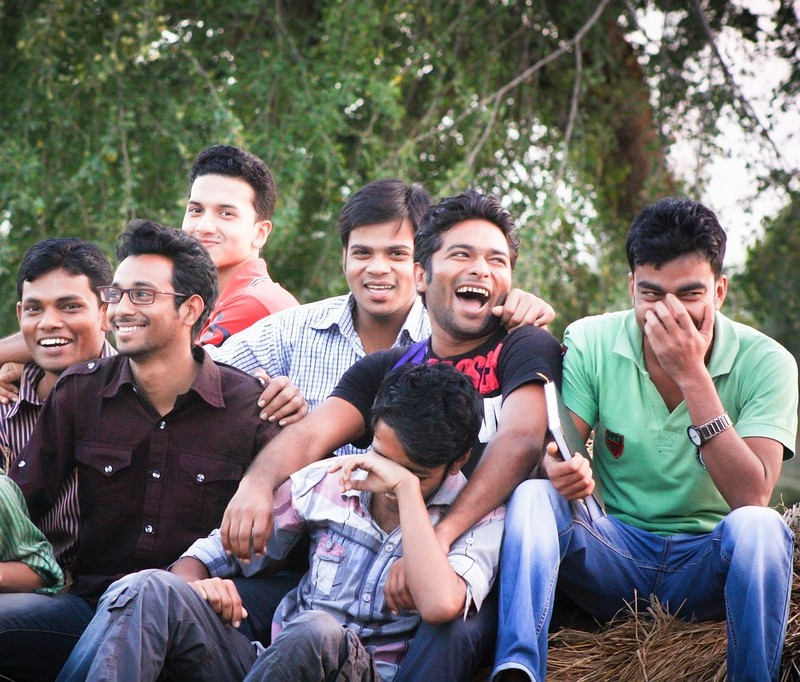11.1 Group Membership

Each of us is an individual with our own goals and desires, but we are also members of groups, and these groups guide us, support us, sustain us, and, when necessary, constrain us. By joining a group, we satisfy our need to belong, gain information through social comparison, define our sense of self, and achieve goals that we couldn’t achieve if we worked alone. We often turn to groups when important decisions must be made, and this choice is reasonable and justified as long as we avoid issues like infrahumanization, negative stereotypes, and discrimination.
Learning Objectives
- Describe how cultural influences impact our interactions with each other.
- Explain how groups influence individual behavior.
- Explain how social roles have impacted your personality.
Social psychology is especially interested in the effect which the social group has in the determination of the experience and conduct of the individual member.” George M. Mead

Humans have a desire to make friends, start families, and spend time together.
Importance of Group Membership
Psychologists study groups because nearly all human activities (e.g., working, learning, worshiping, relaxing, playing, and even sleeping) occur in groups, and these groups profoundly impact our thoughts, feelings, and behaviors. Some researchers believe that groups may be humans’ most useful innovation that facilitates social norms and language development (Aiello & Dunbar, 1993; Henrich, 2016; Richerson & Boyd, 2005). Groups provide us with the means to reach goals that we otherwise wouldn’t have if we remained alone. The advantages of group life may be so great that humans are biologically prepared to seek membership and avoid isolation.

The need to belong is a strong psychological motivation.
The Need to Belong
Across individuals, societies, and even eras, humans consistently seek inclusion over exclusion, membership over isolation, and acceptance over rejection. As Roy Baumeister and Mark Leary conclude, humans need to belong: “a pervasive drive to form and maintain at least a minimum quantity of lasting, positive, and impactful interpersonal relationships” (1995, p. 497). And most of us satisfy this need by joining groups. When surveyed, 87.3% of Americans reported living with other people, including family members, partners, and roommates (Davis & Smith, 2007). The majority, ranging from 50% to 80%, reported regularly doing things in groups, such as attending a sports event together, visiting one another for the evening, sharing a meal together, or going out as a group to see a movie (Putnam, 2000).
People who are accepted members of a group tend to feel happier and more satisfied. But should they be rejected by a group, they feel unhappy, helpless, and depressed. Studies of ostracism—the deliberate exclusion from groups—indicate this experience is highly stressful and can lead to depression, confused thinking, and even aggression (Williams, 2007). When researchers used an fMRI (Functional Magnetic Resonance Imaging) scanner to track neural responses to exclusion, they found that people who were left out of a group activity displayed heightened cortical activity in two specific areas of the brain, the dorsal anterior cingulate cortex and the anterior insula. These areas were associated with the experience of physical pain sensations (Eisenberger et al., 2003). It literally hurts to be left out of a group.
Identity and Membership
Groups not only satisfy the need to belong, but they also provide members with a sense of identity, the universal construct that is shaped by our view of ourselves and how we are recognized by others. Demographic qualities such as sex or age can influence us if we categorize ourselves based on these qualities. Social identity theory asserts that we categorize ourselves and form a social identity based on the degree to which we identify as a member of a particular social group (e.g., man, woman, Anglo, elderly, or college student) (Tajfel & Turner, 1979, 1986). We don’t just classify ourselves. We also categorize other people into social categories. Social identity theory explains our tendency to favor an in-group (people we perceive to be like us) over an out-group (people we perceive to be different from us).

When we strongly identify with our favorite sports team, we are willing to make personal sacrifices and are likely to experience strong emotions related to wins and losses.
When we strongly identify with an in-group, our own well-being becomes bound to the welfare of that group, which increases our willingness to make personal sacrifices for its benefit. We see this with sports fans who heavily identify with a favorite team. These fans become elated when the team wins and sad when the team loses. Heavily committed fans often make personal sacrifices to support their team, such as braving terrible weather, paying high prices for tickets, and standing and chanting during games.
People also take credit for the successes of other in-group members, remember more positive than negative information about in-groups, are more critical of the performance of out-groups than of in-group members, and believe that their own groups are less prejudiced than out-groups (Shelton & Richeson, 2005). Attitudes and beliefs about out-groups are often associated with infrahumanization, which is the tendency to see out-groups as less human or as having less humanity than in-groups (Vaes et al., 2004). We have seen this in history as a justification for genocide or ethnic cleansing (Castano & Giner-Sorolla, 2006). Though a strong group identity can bind individuals together, it can also drive divisions between different groups, reducing overall trust and cooperation on a larger scale. People are generally less likely to cooperate with members of an out-group (Allport et al., 2000).
Group Interactions and Culture
Triandis and colleagues (1988) found that in-/out-group relationships were highly correlated with individualistic and collectivistic values of cultures. Members of individualistic cultures belong to multiple in-groups and move easily from one in-group to another. People from individualistic cultures were not attached to any one single in-group because they belong to many. Additionally, members were more likely to treat out-group persons more equally, with less distinction between in-groups and out-groups. Individuals from collectivistic cultures tended to belong to fewer in-groups than those from individualistic cultures, but had much greater commitment to the groups they belonged to.
Consider if a group leader (e.g., politician, chief, religious figure) has to decide between providing financial support for one program or another. She may be more likely to give resources to the group that more closely represents her own in-group. This psychological process of being more comfortable with people like yourself can have important and lasting consequences for the out-group members. In-group favoritism (preferences for the in-group) is found in many different types of social groups, in many different settings, on many different dimensions, and in many different cultures (Bennett et al., 2004; Pinter & Greenwald, 2011). In-group favoritism also occurs on trait ratings, such that in-group members are rated as having more positive characteristics than are out-group members (Hewstone, 1990).
Van de Vliert (2011) examined in-group favoritism using three major components that shape culture: ecology, resources, and people. Using data from almost 180 countries, in-group favoritism was highest in cultures with the lowest income and harshest, most demanding climates (e.g., extreme heat or cold) and lowest in cultures with high national income and less demanding climates. By examining ecology, national wealth, and group preferences collectively rather than individually, a picture begins to emerge that suggests in-group favoritism likely co-evolved with culture as groups adapted to survive ecological challenges with limited resources.
Test your understanding
Media Attributions
- pexels-rdne-7335321 © RDNE Stock Project is licensed under a CC BY (Attribution) license
- pexels-gabby-k-5384538 © Monstera Production is licensed under a CC BY (Attribution) license
- tuhin © Ns Tuhin is licensed under a CC BY (Attribution) license
- Brazil_and_Colombia_match_at_the_FIFA_World_Cup_2014-07-04_(37) © Danilo Borges is licensed under a CC BY-SA (Attribution ShareAlike) license

